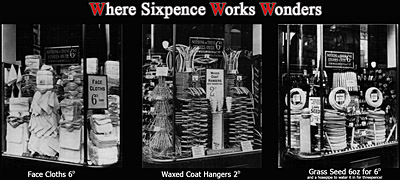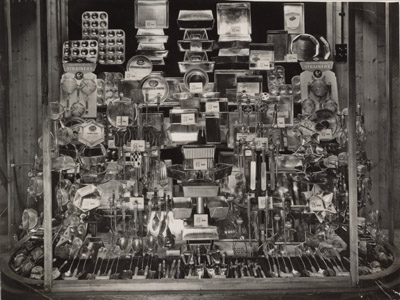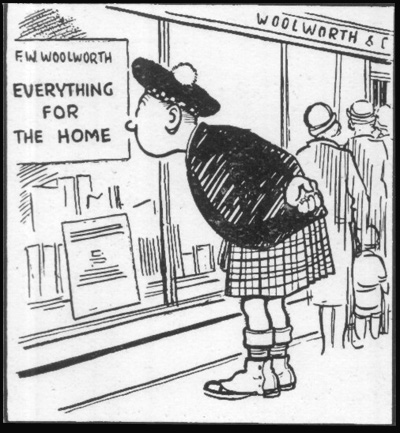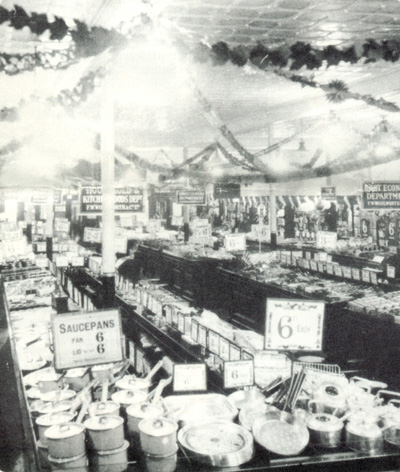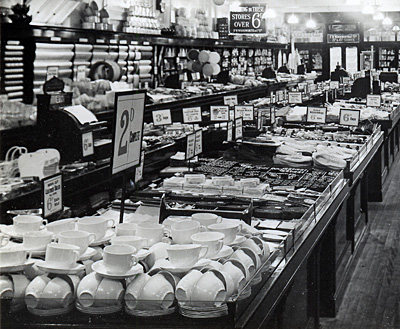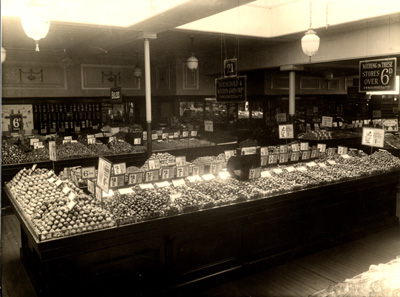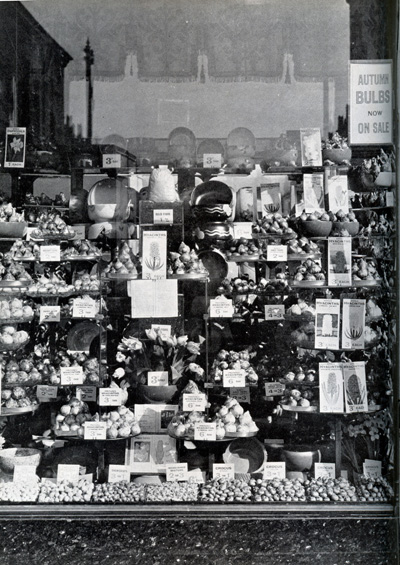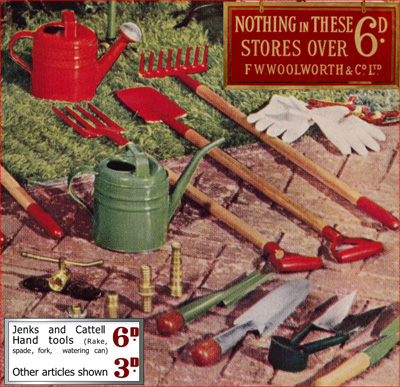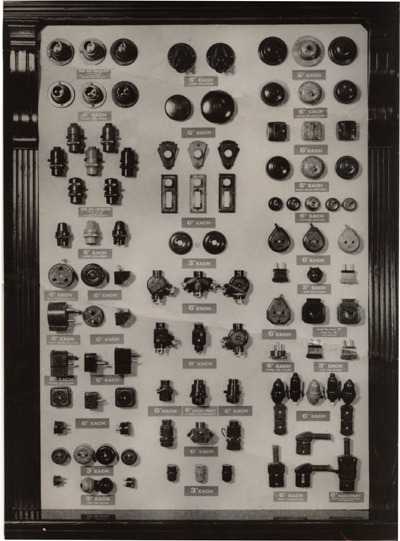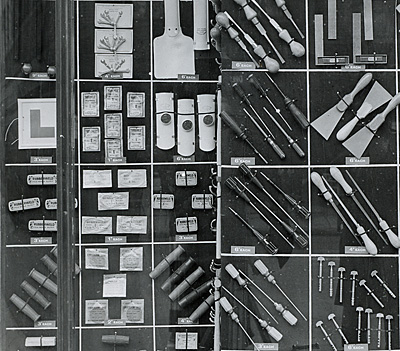Remembering the Thirties: Show me the way to go home
In the 1930s Woolworths was famous for their range of homewares, with the everyday essentials
that ordinary people needed to keep the home fires burning, pans on the stove and to keep
everything ship-shape and Bristol-fashion, even when money was tight.
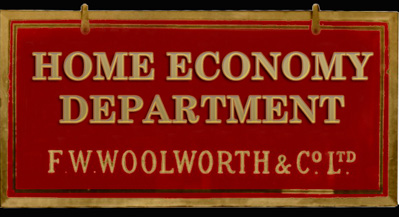
Our special offers today include:
Face Cloths in Lancashire Cotton - sixpence. Waxed wooden coat hangers - tuppence.
Tough grass seed - a penny an ounce. Rubber hosepipes - just threepence.
FWW. Where sixpence worked wonders.
Every item in the window above was made of tin, building to a comprehensive
range of cooking utensils, all of which were available for sixpence or less
from the counters of every Woolworths store in the 1930s.
To find out what the Scotsman bought when he visited his local Woolies
simply click the picture to reveal the rest of the story in a new window.
The cartoon was drawn by a Scottish colleague in 1937 and is
typical of many from the era, promoting the wee prices and the big values,
Saucepans and lids sixpence each (i.e. the two together cost a shilling or twice sixpence) - this was
one of Woolworths' cunning ways of keeping prices under sixpence as inflation struck the British
economy in the late 1930s. The saucepan and lid would cost the equivalent of £4 or $6.80 today.
Simple crockery like cups and saucers were a daily commodity from
Woolworths in the Thirties. If a piece got broken, kids would slip out
to Woolworths and buy another for tuppence (two old pennies, 1p
in decimal currency) and normally mum and dad would notice any
difference! All the china was made in Staffordshire, which a series
of factories in Stoke-on-Trent and Hanley dedicated to producing
goods for the threepenny and sixpenny stores.
A huge display of Spring bulbs at the Woolworths store in Kilburn, London in the early 1930s.
These were sold loose at prices for one old penny for a daffodil to sixpence for a specimen hyacinth.
The appearance of garden bulbs in Woolworths' windows, which changed twice a week,
was a sure sign that Spring had sprung. The street-side display was intended to
lure the public in to view large island counters full of everything needed for the
garden, which went on sale towards the end of February each year.
It's hard to believe now, but Woolworths were able to offer garden tools with wooden handles and
iron finials, painted in a bright red, for just sixpence in the 1930s. That would be the equivalent
of just £2.11 today ($3.60).
The products, manufactured in Wales by Jenks and Cattell sold
in vast quantities. The firm made virtually no profit on these items, using them to promote the
view that Woolworths could sell just about anything for sixpence and was simply the best value
shop in Britain. Little wonder perhaps that they pushed the boat out on some colour pictures.
Back in the Thirties many poorer households were still lit with gas. Some had not invested
in electricity at all.
Woolies offered a wide selection of electrical accessories, all made in bakelite, which
was the new miracle substance of the age - a very early type of plastic. Everything in the range, from
switches to sockets to switches and lampholders was sixpence or less. Everything was British made, with
most products coming from H. H. Electrical or Astralec Industries of Mitcham Surrey, which was part-owned
by the giant Edison company founded by the great inventory of many of the luxuries we're used to today.
The products themselves were stuck to a board with cow gum, along with the labels, upstairs
in the store's stockroom and then gently carried into place for the window. Some stores
also kept a display like this on the wall, to show all the products which were displayed
in small glass compartments on top of the mahogany counter below.
Finally, to complete the picture, here is some of the large assortment of hand tools that were available
from Woolies for sixpence or less in the 1930s. Clicking the picture reveals more of
the display in a much higher resolution picture in a new window.
COPYRIGHT NOTICE:
This feature, is divided into a number of
separate galleries of pictures.
Thumbnail pictures are displayed in the gallery. If you click on them
you can zoom in to see a very high resolution version of the image in a new browser window.
The images are © Copyright 3D & 6D Pictures, 2010 - All Rights Reserved.
The pictures shown may not be copied or reproduced without consent. Many appear in the book
A Sixpenny Romance, celebrating a century of value at Woolworths
which was published on 5 November 2009.
PLEASE PICK A GALLERY:
Mass Production Eclectic Products Cheap Sweets Household Goods
Nothing over 6D Working at Woolies Give me a ring!

